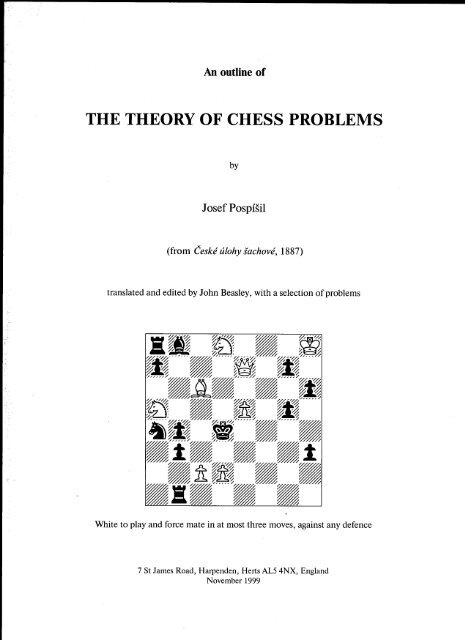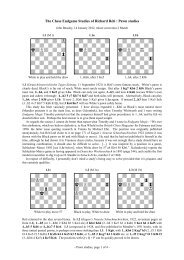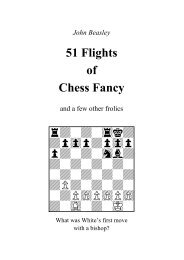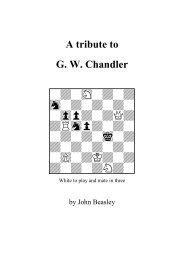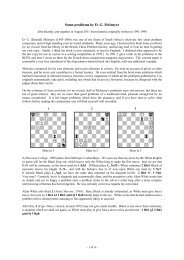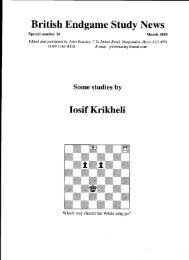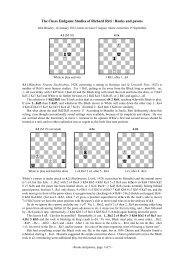THE THEORY OF CHESS PROBLEMS - John and Sue Beasley
THE THEORY OF CHESS PROBLEMS - John and Sue Beasley
THE THEORY OF CHESS PROBLEMS - John and Sue Beasley
- No tags were found...
You also want an ePaper? Increase the reach of your titles
YUMPU automatically turns print PDFs into web optimized ePapers that Google loves.
An outline of<strong>THE</strong> <strong>THE</strong>ORY <strong>OF</strong> <strong>CHESS</strong> <strong>PROBLEMS</strong>Josef Pospi5il(from Ceskd titohy iachovd,lS87)translated <strong>and</strong> edited by <strong>John</strong> <strong>Beasley</strong>, with a selection of problemsWhite to play <strong>and</strong> force mate in at most three moves, against any defence7 St James Road, Harpenden, Herts AL5 4NX, Engl<strong>and</strong>November 1999
Typeset <strong>and</strong> published by <strong>John</strong> <strong>Beasley</strong>,7 St James Road, Harpenden, Herts AL5 4NX, Engl<strong>and</strong>Printed by Fastprint <strong>and</strong> Design,9 London Road, St Leonards on Sea, East Sussex TN37 6AE, Engl<strong>and</strong>November 1999Publisher's notice. I have no authority to waive the rights of others, but as far as I am concernedanything in this document may be reproduced without payment or formality; I ask only that there bedue acknowledgement.
An outline of<strong>THE</strong> <strong>THE</strong>ORY <strong>OF</strong> <strong>CHESS</strong> <strong>PROBLEMS</strong>byJosef PospiSil(from ieskd titohy iachovd,1887)translated <strong>and</strong> edited by <strong>John</strong> <strong>Beasley</strong>, with a selection of problemsTranslator's introduction. Although the exposition of Bohemian chess problem theory in Josef Pospi5il's bookCeskd tilohy iachovd has long been recognized as one of the most important texts in chess problem history, thereappears until now to have been no readily available version of it in English. This has been a serious gap in theproblem literature of our language, <strong>and</strong> I hope the making of this translation will fill it. I have accompanied it bya selection of problems from the book, kindly chosen for me by Vladimir Kos, <strong>and</strong> by a brief essay of my ownwhich looks back after the passage ofa hundred years.I am grateful to the library ofthe British Chess Problem Society for access to a copy of ieskd illohy iachovd,<strong>and</strong> to Jiii Jelinek for highlighting the differences between the Czech of 1887 <strong>and</strong> that ofthe present day. Jiii hasgone so far in his support as to send me a transcription of the entire text into modern Czech, which has provedinvaluable in elucidating some obscure passages. Literary fashion has changed both in Bohemia <strong>and</strong> in Engl<strong>and</strong><strong>and</strong> I have simplified or eliminated some passages which seem unduly laboured or repetitive to a modern reader,but I believe that everything which mattors has been fully <strong>and</strong> faithfully reproduced.ContentsForeword by Antonin Kvidalal.73.IntroductionThe problem as a chess creationContentMainplay <strong>and</strong> variationsOriginalityCorrectnessThe problem as a work of artPurity of mateComparability of aims <strong>and</strong> meansThe initial positionArtistic considerations affecting constuctionThe problem as a puzzleDifficultyConclusionsThe Bohemian problem schoolA selection of illustrative problemsSome comments from a hundred years onf666678889l0t2I213l3t4203-
Foreword by Antonin KvidalaTranslator's note. This foreword was written by Kvidala, himself both a player <strong>and</strong> a problem composer, on behalfof the Bohemian Chess Association in Praha (Prague) of which he was chairman.Chess problems represent the pinnacle ofchess art. And even though the problem is the branch ofchess that hasdeveloped the most recently, it has flowered in a relatively short time in a way which few would have suspected.Bohemian composers have not been backward in this development. On the contrary, as has been shown bythe developments of the last 25 <strong>and</strong> more particularly of the last l0 years, they are universally recognized asdeserving a large part of the credit. The Bohemian school, whose principles flow from the eternal <strong>and</strong>inexhaustible sources of beauty <strong>and</strong> harmony, is now known the world over; <strong>and</strong> not only to specialists, but alsoto the general enthusiast to whom the solution or study of chess puzzles is providing a pastime ever moreenjoyable <strong>and</strong> fulhlling. And this fame is continuously increasing, due to the numerous chess publications whicheverywhere pay gracious <strong>and</strong> unaffected homage to "the Bohemian problem school".However, even the compositions of lasting value which this school has produced so abundantly have beenscattered until now in newspapers <strong>and</strong> in foreign publications, <strong>and</strong> we have lacked a collected work in which atleast a representative sample of its fruits could be displayed. Accordingly, the Bohemian Chess Association inPraha, which is our chief national representative body for chess, has taken upon itself the duty of presenting theresults of these 25 years of successful development in the form of a collection of works each of which is bothoriginal <strong>and</strong> meritorious.This project, originally taken up within a very narrow circle, has come to fruition in the face of more than oneobstacle, <strong>and</strong> we believe it fully satisfies the resolution passed by the general meeting of our association in Januaryofthis year.This collection has been the responsibility of our leading composers, Jan Dobruskj, Jan Kotrd, <strong>and</strong> JosefPospi5il. They have received enthusiastic support from FrantiSek Moudka, who with Jan Karel has untertaken thetechnical <strong>and</strong> administrative burden. An introduction of premanent value, laying down the special principles ofthe Bohemian school, has been contributed by Josef Pospi5il. And for the fact that this collection worthilyrepresents our best chess endeavours, which hitheno have been far better known abroad than at home, theprincipal credit is due to the composers whose names appear above the individual diagrams.We add that most of the problems here collected appeared during the period 1868-1887 in our literary journalswhich contain chess columns, in particular Svdtozor, Humoristickd listy, Paleiek, Zlatti Praha, <strong>and</strong> Sv<strong>and</strong>fiv dudtik,<strong>and</strong> in the sadly short-lived specialist magazine Sach-mat.And may this co-operative work serve to honour <strong>and</strong> enrich the name of Bohemia in this internationaltournament ground of intellectual endeavourlPraha (Prague), December 1887.-4-
An outline of<strong>THE</strong> <strong>THE</strong>ORY <strong>OF</strong> <strong>CHESS</strong> <strong>PROBLEMS</strong>IntroductionChess provides an almost inexhaustible flow of marvellous combinations. These combinations have a magicalimpact on players encountering the game for the first time, <strong>and</strong> this attraction increases as their knowledge of thegame increases.Every game of chess is made up from such combinations, sometimes simple <strong>and</strong> obvious, sometimes deeplyprofound. Combinations also form the basis of chess problems. Certain positions from games, whose resolutionrequired particularly attractive play, went round the world <strong>and</strong> became the common property of all chess players;<strong>and</strong> being thus broadcast, they awoke the natural desire to construct further positions, not this time dependent onthe accidents of actual combat, whose resolution required surprising manoeuvres which were left for the solver todiscover. This we meet the origin of the chess problem.Of course, the objective of practical play is to win the game . Combinations may form the basis of play, butthey are not an end in themselves. Problems, having originated from play, at first presented winning manoeuvressuch as occur in games, <strong>and</strong> in this respect they had a certain didactic value. But for many centuries problemswere only the Cinderella of the game, <strong>and</strong> the vast majority of enthusiasts concentrated on the practical game.However, the ideas that the practical game could provide for embodiment in problems were eventually foundto be too monotonous, too limited, <strong>and</strong> it became recognized that the seeking out of interesting combinationsfrom the inexhaustible well of chess was an activity no whit less enjoyable than playing an actual game. So theproblem entered a new <strong>and</strong> quite different epoch, one that has led to rapid development <strong>and</strong> expansion. Now theaim of a problem was not to show something likely to be useful in practical play, but simply <strong>and</strong> solely to displayan interesting combination in a beautifulform.In older problems, the germ of the idea was buried in a mass of commonplace <strong>and</strong> irrelevant moves, oftendisfigured by conditions foreign to true chess; the idea was offered in settings which were pedantically game-like;all these distracted attention from the manoeuvre which was the true purpose of the problem. In place of this, thenew epoch dem<strong>and</strong>ed only the most beautiful mating sequences in from two to five moves, <strong>and</strong>, in sharp contrastto a normal game, no account was taken of the initial equilibrium of the forces. In this form, the modernproblem shows us all the most sophisticated manoeuvres of chess. Here, the combinations of practical play areidealized, they become not only the basis of the problem but its sole aim; therefore it is natural to try <strong>and</strong> presentthem cleansed from all irrelevant <strong>and</strong> disturbing influences, in a word to present them refined into perfect form.Works which retain their practical aims, which demonstrate combinations of practical interest without regard torefinement of form, are now distinguished from true problems, <strong>and</strong> they belong wholly to the theory of thepractical game.Although the problem has thus become divorced from the practical game, it remains of course a true chesscreation. However, by its idealization of combinations, it becomes, to look on it yet another way, a work of art.The concept of beauty occurs in all artistic work, be it a painting, a piece of music, or a literary composition;each of these fields is governed by certain aesthetic laws, which have gradually evolved during many years ofpractice <strong>and</strong> experience. So it is with the problem. As experts have penetrated more deeply into the secrets of thegame, certain aesthetic rules peculiar to chess have emerged, <strong>and</strong> these show the direction in which the artisticrefinement of combinations should prqceed. By this means, the form of problems has gradually achieved a whollyunexpected level ofperfection, entitling us to use the proud termproblem art.But here let us leave comparisons with other art forms, for we must not forget that the subject of a chessproblem is merely a game; it has no true basis in nature, <strong>and</strong> does not give any direct benefit to mankind.However, only an expert can judge whether the title "art" is justified, <strong>and</strong> in our case this judge is the chess world,which has already firmly accepted it.And we must not forget that a problem has yet another side. It is a puqle; its solution is something initiallyunknown, that the solver has to find. The combinations in a problem are concealed; the solver realises theirvalidity only when he has himself discovered them.So we see that a problem has three aspects: a chess creation, a work of art, <strong>and</strong> a pugle. Our exposition of itstheory will take account ofall three characteristics.-5-
1. The problem as a chess creationA. ContentThe contents of a chess problem are its combinations; but the number of possible chess combinations is so large,<strong>and</strong> their forms so diverse, that to describe them in a few words is quite impossible. The theme of a problem restssometimes in a single surprising move, sometimes in a beautiful mate, sometimes in an interesting line of playspanning several moves, but most often in a harmonious blending of individual moves <strong>and</strong> final result.But if a complete <strong>and</strong> comprehensive analysis is out of the question, we can at least highlight the mostcommonfundamental elements from which problem combinations are constructed.One simple element is the decoying of a man away from a crucial square. Such a man has an importantdefensive role in its original position, <strong>and</strong> only after it has moved away can the solution proceed. This simplemotif is encountered very frequently, <strong>and</strong> plays a more or less important part in the majority of problems. Theconverse motif also occurs, where a man is lured to a crucial square.Another common motif is the freeing of a square so that another man can occupy it. Again, we also have theconverse manoeuvre, the blocking of a square in order to deny it to some other man. This is particularly commonin the creation of a mating position.Yet another simple motive is line clearance, the removal of a man from a line so that another man can travelalong it. Here again we also find the converse motif, the limitation of the field of action of a man. And the theme ofa problem can also subsist in demonstrating the particular powerc of a single piece or the harmonious action of two ormore pieces, often culminating in sacrfices. These can be sometimes merely the means to the realization of atheme, sometimes an end in themselves.These are the most important elements from which problem themes are built. But a theme rarely consists in asingle such manoeuvre. Usually it consists in an harmonious whole constructed from various elements, the mosioutst<strong>and</strong>ing of which form the problem's reasonfor existence.B. Mainplay <strong>and</strong> vuriationsThe idea of a problem is realized by a series of individual moves by the attacking <strong>and</strong> defending sides. By longestablishedconvention, the attacking side is always denoted by White.The principal idea which the author wishes to show in his problem comes into existence only after certainmoves of the defender. This forms the most important part of the problem's content, its mainplay. But Black alsohas at his disposal a greater or smaller selection of other moves, each of which also allows White to achieve hisaim within the stipulated period. Thus we have variations, which can originate at any point in the play. Thisenhancement of problem content by the use of variations is very important.Where the primary attraction of a problem lies in a particular variation, we can talk about the principalvariation of a problem. But often a problem contains additional variations of almost the same value, <strong>and</strong> in such acase its true theme lies in the harmonious blending of several attractive lines of play into a single whole.Almost all problems contain side variations, which do not contribute to its thematic content. While these addnothing to its artistic value, they may be important in increasing its difficulty. Even so, we shall not count aproblem as perfect when a single pretty line is accompanied by a whole raft of worthless variations; inevitably, thecomparison comes to mind of a pearl among rubbish.C. OriginalityThe requirement of originality, so important in all artistic work, cannot be underestimated even in the problem.A genuinely new <strong>and</strong> original idea gives a problem value even in the face of constructional defects, the more so ifwe take into account how difficult it is to achieve true originality.Nowadays, when some thous<strong>and</strong>s of different chess combinations have been presented as problems, it hasbecome necessary to seek originality not in the basic manoeuvres themselves, which are limited in number, but infinding different <strong>and</strong> ever more perfect renderings. In place of intrinsic originality, we have rather originality inthe means of realization. In this sense, chess combinations are truly inexhaustible.The greatest scope for variety <strong>and</strong> freshness of thought lies in problems whose theme consists in the blendingof several interesting lines of play into a unified whole. Clearly, no less originality lies in such a blend than inmany problems where the so-called theme, if we examine it more closely, takes the form of a manoeuvre which isinfrequently seen because it is difiicult or impossible to realize along artistic lines, or even where the originalitylies merely in the unsatisfactory form of the problem <strong>and</strong> in its complete disregard for normal artistic principles.It is difftcult to show something truly new in a single variation, <strong>and</strong> it follows that problem activity in thefuture will concentrate more <strong>and</strong> more on harmoniously contrived sets of attractive variations. It is the chiefmerit of our Bohemian problemists that composition of this nature has taken deeper root here than anywhere elsein the chess world. True, the principle is everywhere acknowledged that attractive variations enhance a problem,but the true importance of this principle is still imperfectly understood. Rather, we see the gross undervaluing of-6-
many problems which feature several variations of equal value, on the grounds that they do not have a truemainplay but only variations.The requirement of originality places no light burden on the composer, but even so he must be on his guardagainst banality, whether it lies in the use of hackneyed manoeuvres or in the automatic multiplication ofvariations. He must give inject some fresh vigour into his work, either by the ideas he incorporates or by theoriginal ways in which he realizes them.D. CoryectnessFrom the name itself, it is apparent that without correctness a problem is nothing. Incorrectness can take variousforms, be it incotectness of content or incorrectness of position. A problem is incorrect in content if the solver canavoid the author's intended play <strong>and</strong> solve it in another way, still reaching mate in not more than the givennumber of moves.A correct problem has only one first move which leads to the required result. If there is more than one, theproblem has a complete additional solution, <strong>and</strong> it is not correct.Avoidance of the intended play can also occur on the second or third move, in which case we say that theproblem has a partial additional solullor. Such a solution invalidates the problem if it occurs in the mainplay or ina thematically important variation, <strong>and</strong> devalues it if it occurs in a variation which would otherwise enhance theartistic content of the problem. However, most problems also contain variations of no artistic value, <strong>and</strong> we calladditional solutions in such variations duals. Needless to say, they have no influence on the value of the problem.A dual cannot detract from the beauty ofa variation ifthere is no beauty to detract from.(Translator's note. I have thought it appropriate to translate the Czech terms literally on their firstoccurrence, but our modern English usage is cook for Pospi5il's complete additional solution <strong>and</strong> dual for his partialadditional solution, duals being classified as signfficant If they bypass thematic play <strong>and</strong> insignificant otherwise, <strong>and</strong> toavoid confusion I have rendered PospiSil's "dual" as "insignificant dual" in what follows. Modern Bohemianusage is in fact somewhat different from Pospi5il's, "additional solution" being used for a solution which divergesat move I <strong>and</strong> "dual" for a solution which diverges later <strong>and</strong> bypasses some of the thematic play; non-thematicplay is normally ignored whether it is dualized or not.)The deeper <strong>and</strong> more complicated problems can rarely be set without insignifrcant duals. The removal ofthese duals is either not possible at all or possible only at an unacceptable artistic cost. The defending side usuallyhas at its disposal several bad moves, which present the attacker with several routes to his goal or allow him toattain it in fewer than the required number of moves. To deny the defender such moves would be pointless oreven impossible. Insignificant duals are also a feature of problems employing multiple threats; also, in particular,of four-movers, where their removal is often wholly impossible.On the other h<strong>and</strong>, a problem cannot be considered perfect if thematic content which is less than outst<strong>and</strong>ingis accompanied by a mass of dualized variations. In such a case, even "insignifrcant" duals lower the value of theproblem.A similar effect is caused by an alternative mating move. lf it occurs in an attractive pure mate which is part ofthe thematic play, it destroys or at least reduces the value of the problem; but it is unimportant if it occurs in amate without artistic value, even if this occurs in the mainplay or in an important variation.An inversion of moves, which sometimes occurs particularly in simple problems, is treated in the same way asan additional solution or dual.This has dealt with correctness of solution; but the problem retains some connection with the parent game, inthat it is an idealization of a game, <strong>and</strong> it follows that legality of position is a further requirement. Of course, thereis no need to demonstrate the legality of every problem position by playing a game to it; rather, the need is merelyto demonstrate when a position is impossible, for example one with Black pawns onfl, g7, h7, <strong>and</strong> h5. Often thedemonstration consists in looking at the number of pawn captures that must have been made; if these exceed thenumber of men missing from the other side, the position is clearly impossible. If it is not possible to demonstrateimpossibility by some such means, the position should be taken as legal. Again, we sometimes come across aposition such as the following: White Bc5, Pb2, Pd2. Such a bishop could not have arisen other than by thepromotion of a pawn, <strong>and</strong> the position is called "relatively impossible". Such a problem cannot be regarded aswholly correct, <strong>and</strong> the more strict ofjudges would not allow it to compete in a tourney.1
2. The problem as a work ofartA. Purity of mateThis requirement creates the first special rule of chess aesthetics. A mate is pure if each square in the king's fieldis either covered by a single attacking man or blocked by a defending man. For example, the mate in the lefth<strong>and</strong>diagram below is pure, because squares e6, d5, <strong>and</strong> c4 are covered by the White bishop <strong>and</strong> by no other man,d4 <strong>and</strong> e5 by the knight alone, c6 <strong>and</strong> d6 by the king alone, <strong>and</strong> c5 <strong>and</strong> e4 are blocked by Black men <strong>and</strong> are notcovered by any White man. In contrast, the mate on the right is far from pure, because e5 <strong>and</strong> c5 are covered byboth queen <strong>and</strong> rook <strong>and</strong> c4 is both blocked by the Black bishop <strong>and</strong> covered by the White king.%The principle of purity of mate does not perhaps go so far as to dem<strong>and</strong> that every mate in a problem be pure,but the more pure mates a problem contains the higher is likely to be its aesthetic value. One condition that isnecessary, however, is that at least one mate in the mainplay be pure. And unless a variation results from somespecial feature in the play, we regard it as significant only if it leads to a pure mate.The theme of many problems consists in harmonious combinations of pure mates.From time to time we come across examples where a mate is in principle impure, but can still be treated aspure. This happens particularly in the case of mates given by double check. For example, in the left-h<strong>and</strong>diagram below, where White has just given mate by Rf5, the square d5 is doubly covered, but it is possible to givesuch a mate the st<strong>and</strong>ing of a pure mate, or in other words the requirements of purity often apply only to the eightsquares surrounding the Black king. (Translator's note. This is indeed what Pospi5il says. Nowadays, we regardsuch a mate as pure only if both checks are necessary, as would be the case here were the Black bishop on e6 to bereplaced by a Black queen.).,ffi,,Kffi,%%ry,,^'A similar case arises when a pin is necessary to create the mate. The mate on the right is impure on accountof the square e4, but the necessity of the pin reduces the impression of impurity <strong>and</strong> in many cases such a matecan be treated as equivalent to a pure mate.In many problems, where the main interest lies in the unfolding of the solution <strong>and</strong> the mate is merely thenecessary termination of the play, even a complete absence of pure mates can often be overlooked; but such aproblem cannot be regarded as perfect, <strong>and</strong> so we often see reworkings of old ideas in a more artistic form.The requirement of purity of mate is not an arbitrary rule imposed by the caprice of individuals, but rather theresult of an attempt to reline the play right up to the mating move. This idealization is based on the most refinedutilization of the position <strong>and</strong> of the available material, on the elimination of everything superfluous, <strong>and</strong> theretention only ofthe necessary interplay between the attacking <strong>and</strong> the defending forces.B. Comparability of aims snd mesnsThe refinement of combinational play leads to the further requirement of economy of means. The reason isperhaps the same as above. The principle manifests itself in numerous ways, but its most important requirementis that every White piece still on the board should participate in the mate in the mainplay; should a piece not beneeded in the mate, it must be sacrificed at some point in the play. This requirement does not apply to the Black-8
men, nor to the White pawns <strong>and</strong> king.It is of course unrealistic to dem<strong>and</strong> strict economy of force in every mating position in a problem, but theminimum requirement is that at least one mate in the mainplay be economical. Of course it is better if theremaining mates are economical as well. In problems whose theme is the harmonious combination of variations,the requirement of economy applies to each of the thematic lines.But the principle of economy also dem<strong>and</strong>s that as much advantage as possible be taken of the powers of theattacking men. The relative power of the pieces should show itself even in the guarding of the king's field in themate; the more powerful pieces should shoulder the greater part of the burden. Neglect of this principle, unlessinherent to the theme of the problem, always gives a bad impression.Economy applies most tellingly to the concept of beauty of mate. An unnecessary White pawn, sitting in theBlack king's field, gives a most unfortunate impression to an onlooker of taste <strong>and</strong> discernment; similarly, thepresence of several White men in the mating freld, even if they are needed to guard squares, does not conduce tothe most beautiful of mates.The concept of economy applies to the whole of the solution; not only must the men be used effectively inthe final position, they must also contribute to the play leading up to it. The less a man is used in the mate, themore important a role it must fulfil in the preceding play.Again, an unfortunate impression is given if a powerful man does not take an active part in the solution, but isconfined to passive guard duty. There must always be a balance between active <strong>and</strong> passive duty. A man whichplays only an insignificant role in one variation must be given a correspondingly greater role in another.A further principle of economy is that of obtaining great results from small means. The ideal is that rich <strong>and</strong>attractive play should be produced by apparently insignificant force; if the author uses a lot of powerful men, wedem<strong>and</strong> correspondingly impressive results. We judge a problem more harshly when its content fails to match upto the material used to construct it.Obviously, the principle of economy of force does not apply only to the White men, but to some extent also tothe Black.The absolute requirement is that every man on each side be necessary to the problem. The ratio of the menon each side is irrelevant. We are not talking just of a victory for one side or the other, but of victory within agiven number of moves; the difficulty lies not in achieving the victory itself, but in clinching it as quickly aspossible. Nor does it matter if the side trying to hinder or delay victory disposes of relatively little force. It issuperfluous to attempt to equalize the forces of the two sides in a problem, or to give the defender a Ereatpreponderance over the attacker; but it has to be said that a complete deficiency of force on the defending sidegives an unfortunate impression unless it is compensated by some point of particular thematic interest.To eliminate a gross disproportion of force by adding unnecessary Black men is wholly to be condemned.The most that is permitted is to replace a weak but necessary man, such as a pawn, by a stronger one.C. Ihe initial positionThere are several artistic considerations affecting the starting position of a problem: the appearance of theposition in itself, its connection with the assumed game leading up to it, <strong>and</strong> its connection with the play leadingforward from it.The importance of the starting position, which creates a kind of interface between the assumed introductorygame <strong>and</strong> the subsequent solution, is obvious. The position is the outward form of the problem. It makes theinitial impact on the judge or solver, <strong>and</strong> contributes significantly to his or her subsequent judgement byawakening a friendly or hostile mood.A position is attractive if there are not too many men on the board, either as a whole or in any particularregion. Rather, the pieces should be evenly distributed, so that the attackers <strong>and</strong> the defenders alike have a freerange of action. Neither should too many men be open to capture, whether they be White or Black. In the sameway, too many pawns on the verge of promotion give an unfortunate effect; in particular, White pawns on theseventh rank are to be avoided as much as possible. Doubled pawns give a poor impression, <strong>and</strong> still worse aretripled pawns <strong>and</strong> opposing pawns which are on the same file having passed each other in play.Additionally, the position must be easily <strong>and</strong> plausibly reachable in play; it should not betray such signs asmight lead the observer to try to prove illegality, because the moves needed to refute such an attempted proof arelikely to be the reverse of plausible. This applies particularly to implausible positions of the pawns <strong>and</strong> to thepresence of large numbers of men in the middle of the enemy camp. On the other h<strong>and</strong>, if there are only a fewmen on the board it hardly matters whether the majority of the White men occupy the lower four ranks <strong>and</strong> theBlack men the upper four.The position of the king is also important, <strong>and</strong> we prefer to see it in its own camp. We cannot regard aposition as attractive ifthe Black king is surrounded by its opponents <strong>and</strong> is far from the pieces of its own side.Similarly, the White king should not be placed in the middle of a group of Black men.All this being said, the requirement of plausibility need not be carried to extremes. We do not require the-9-
assumed game to have featured either a good opening or first-class play. Such requirements might producepositions which would be wholly plausible, but from an artistic point of view very unattractive.The position should also be such as to give no clue to the solution. The men should have a wide choice ofmoves, both in attack <strong>and</strong> in defence. The White men should not be placed at a distance from the battlefield, inpositions where they are clearly useless <strong>and</strong> from which they must be advanced as quickly as possible. A positionis unsatisfactory if the final mating configurations are largely in place at the outset. A particular give-away to theplace of execution is a group of Black men conspicuously placed, <strong>and</strong> White pawns also frequently betray it.A large number of White pawns is never conducive to a beautiful position, either from this point of view or fromthat of the strict requirements of economy.(i) Threat <strong>and</strong> waiting playD. Artistic considerations affecting constuctionIn a game, there are two ways in which the result can be decided. Either the attacking side makes a threat of somekind, <strong>and</strong> the defender, forced to cover this threat, allows some other winning continuation in its place, or theresult is decided by zugzwang: the defender, compelled to move by the rules of the game, has to make a choicebetween weakening moves, <strong>and</strong> these either gradually erode his position or cause his immediate collapse. Ingeneral, wins by threat occur in the middle game, <strong>and</strong> by zugzwang in the endgame.So it is with the problem. The first move may be a direct threat, to which Black has various defences some ofwhich lead to the thematic variations. Alternatively, it may be a waiting move. Here, there is no question ofdefence against a threat, because no threat exists; if the defending side were not forced to move, the attackercould not give mate within the number of moves dem<strong>and</strong>ed. However, the rules of the game do compel thedefender to move, <strong>and</strong> each of his possible moves allows a winning reply.The construction of a problem, be it a threat or a waiting problem, is palpably an important criterion in thejudgement of its value; it is the skeleton on which the problem is built. A threat exerts direct pressure, more orless strong, whereas a waiting move eschews such direct pressure <strong>and</strong> offers something quite different, the delicatecontrol of the complete opposing force. The general principle of refinement of play naturally favours gentlethreats <strong>and</strong> waiting play, <strong>and</strong> deprecates multiple strong threats.A single-move threat, where the key threatens immediate mate, is not something we can commend, but itwould be wrong to disdain it entirely. There are themes which cannot be realized without such a threat. Such athreat is of course a defect, but it is justified until such time as a better setting is shown to be possible. However,when we do need recourse to such a threat, it should be met by a large number of moves, so that neither thekeymove nor the threat itself is unduly obvious.A threat should be as long as the stipulation allows, so a three-mover should feature a two-move threat <strong>and</strong> afour-mover a three-move threat, although in the latter case a two-move threat is also acceptable. It should also beas gentle as possible; a quiet threat is always better than one which proceeds by checks.It may happen that the first move of a problem creates more than one threat. Although we do not stigmatizethis as an irrevocable defect, in the case of the simpler problems, particularly three-movers, it is best eliminated asfar as possible. But complicated more-movers can often be realized only by the use of multiple threats. We assessthe construction according to the strongest threat, <strong>and</strong> the remaining threats usually become part of the variationplay. More rarely, the threat also forms the mainplay. In a problem where several variations are effectively equalin importance, the matter is neither here nor there, but otherwise it is usually best for the mainplay to follow adefensive move rather than to be threatened. And further on in the solution there may be subvariations, whichmay result either from threat or from waiting play.All this reduces to the principle that a long, quiet, gentle threat is to be preferred to one which is short,checking, <strong>and</strong> strong. Waiting play is clearly better still, always provided that the position is not such as to makethe need for a waiting move obvious to the solver.The construction of a problem gives a clear measure of a composer's technique, though naturally only to theextent that he attaches importance to the matter. A problem in which an excellently contrived attacking force isharmoniously united with ingenious use of the defensive force has always the stamp of a masterwork. Suchconstruction in depth can compensate for mediocre content, or, when combined with beauty <strong>and</strong> variety of content,can create a true masterpiece. But just as it is a mistake to underestimate the value of construction, so it is anequal mistake to overestimate it. Sometimes composers forget the importance of the content of a problem, <strong>and</strong>devote all their attention to its form. Just as we do not like to see a beautiful idea in mean clothes, so do we dislikethe opposite. Excellence of construction is not to be sought at the expense of other artistic principles. In particular,waiting play is often attainable only at a cost in other directions. The majority of problem themes, particularly themore complicated themes, cannot be shown in waiting form; but where waiting play does not betray itself by thevarious signs which are obvious to the eye of the expert, we have that very rare thing, the work of a master.Better, however, is a work which is harmonious in all respects than one which is perfect in one respect butbanal <strong>and</strong> aesthetically unsatisfactory in another.l0-
(ii) The nature of the movesThe superficial character of the moves of the solution, as the bearers of the theme of the problem, ties up veryclosely with both the content <strong>and</strong> the form of the problem.The key is particularly important. It carries the greatest responsibility for making the problem difficult; <strong>and</strong>as far as possible it should not merely be the first move of the solution, it should form a substantial component ofthe theme.It is not so much that the key should be apparently the weakest move on the board, superficially the leastattacking; rather, it should be surprising because ofits apparent purposelessness. A good key does not harass theBlack king, take away some of the defensive moves of a Black man or attack him, or bring an important attackingman nearer to the field of battle. A good key does the reverse of all this. In particular, we condemn a check or acapture of a Black piece on the hrst move. Such problems, even if sometimes they embody an idea to which wedo not deny recognition, place themselves outside the framework of established chess aesthetics.The capture of a Black pawn on the first move is something that we are willing to allow in case of need.It usually occurs only in complex problems, where there is no other way of avoiding alternative solutions.Of course, we cannot equip every problem with a good key, but it is for the author at least to examine thepossibility of such a key <strong>and</strong> to see if it can be introduced without otherwise degrading the problem.Nor is the quality of the subsequent moves an indifferent matter. Quiet moves are always preferable to checks;captures <strong>and</strong> exchanges of pieces are too reminiscent of normal play, <strong>and</strong> we do not like them except of coursewhere the theme of the problem is the running down <strong>and</strong> capturing of a certain man. It is always good if the latermoves of the solution have the same qualities as the key, although of course the requirements here cannot be sostrict.If we proceed by checks, their eflect is softened if they are also sacrifices. Sacrihces always enhance aproblem, <strong>and</strong> they often form an important part of the theme. Even more does a sacrifice heighten the eflect of aquiet move. The main purpose of a checking move is to create the mating net or to force the Black king to thedecisive square.The use of checking moves in the middle of the solution usually allows the greatest freedom in placing thedefending men, <strong>and</strong> hence leads to the most attractive starting position. This is their justification; but quietmoves are decidedly to be preferred if they can be achieved without an adverse effect on the initial position.The quality of the moves in side variations is of course irrelevant.The nature of the final mating move is the exact opposite of the key. Its nature has already been explained inthe section dealing with purity <strong>and</strong> economy in the mate. We can characterize it most simply by saying that itmust take the greatest possible advantage ofthe attacking force.(iii) LengrhModern problems are constructed to a length of 2 to 5 moves. Longer problems, formerly so strongly favoured,are now completely eschewed. This reduction in length has led to a condensation <strong>and</strong> crystallization of problemcontent <strong>and</strong> the elimination of everything superfluous, <strong>and</strong> it is usually obvious to the composer from the outsethow many moves his theme will dem<strong>and</strong>. As a basic principle, it is appropriate here to say that a given idea isalways best set in as few moves as possible, <strong>and</strong> this is the principle that the author should always bear in mind.It is often possible to condense <strong>and</strong> improve an idea by setting it in a different form.Again, the defending side's moves must be used to display the theme; they supply part of the introduction,<strong>and</strong> save the need for so many moves by the attacker. Technical mastery usually lies in the proper use of thesetwo principles, which form perhaps the most difficult part of problem technique. It is one of the chief signs whichdistinguish the work of the expert from that of the beginner. The smallest number of moves in which a theme canbe shown is obviously one more than the length of a checking sequence leading to mate. Of course, in many casesit is desirable or even necessary to use more moves, <strong>and</strong> condensation of the theme needs to be reconciled with thedesirability of quiet moves in the solution. A quiet key, in particular, is never a superfluous addition, <strong>and</strong> theharmonious blending of all the moves always brings a problem to tife. To conceal a simple <strong>and</strong> too obvious idea isa frequent reason for increasing the length of the solution, <strong>and</strong> increasing the number of thematic variations <strong>and</strong>improving the construction provide further reasons.The best lengths for a problem are three <strong>and</strong> four moves. Two-move problems normally offer too little scopefor depth <strong>and</strong> difliculty, while five-movers are unduly burdensome. Of course, the same artistic principles arevalid for problems of all lengths, a point particularly to be borne in mind in the case of two-movers.- ll -
3. The problem as a puzzleDfficultyTo attach the term problem to a chess composition implies that not the least of its properties is the difliculty ofuncovering its solution. In this respect a problem is like a puzzle, <strong>and</strong> the more diffrcult this puzzle is to solve <strong>and</strong>the more obscure the combinations that it embodies, the more perfect it will appear from this point of view.Difiiculty of solution is therefore commonly regarded as an important criterion in the judgement of a problem.However, often it is given all too much emphasis; many composers regard it as the most important or even theonly criterion, <strong>and</strong> other artistic considerations are undervalued or wholly ignored.This extreme st<strong>and</strong>point cannot be endorsed. It downgrades the character of something which is primarily anartistic creation, <strong>and</strong> whose puzzle aspect is only a part of its nature. In the true sense of the word, a problem isnever a mere riddle. Put yourself in the position of the solver, <strong>and</strong> ask how much pleasure it gives him to unravela position whose solution is deeply obscure but otherwise without interest or merit. The answer is no pleasure atall; rather, the waste of time provokes resentment. Can difliculty be regarded as an inherently good quality evenin such a case?We therefore count difliculty as a desirable quality only when the solution that unfolds is worthy of it.A problem in which this principle is ignored may be an exceedingly dem<strong>and</strong>ing chess riddle, but it is not a trueproduct of the problem art. For this reason it is ridiculous to try <strong>and</strong> increase the importance of obscurity to thedetriment of other artistic qualities. It often happens that a position is deliberately <strong>and</strong> unnecessarilycomplicated, where the multiplicity of material obscures the clear outlines of the position, <strong>and</strong> where the solverneeds a certain time to unravel what is going on. In other cases, a problem is deformed by the presence of a piecewhich plays no role in the solution <strong>and</strong> eists only to try <strong>and</strong> lure the solver down false paths.Two-movers, in particular, tempt even problemists of strict principle to such violations of the artistic nature ofthe problem. To inject artificial <strong>and</strong> unnatural diffrculty in this way is of course wholly despicable. True diflicultyflows from the nature of the solution itself; it is a natural consequence of true artistic work.Constructional aspects are another source of difficulty, <strong>and</strong> it is the composer's duty to eliminate the slightestclue from the original position. This applies particularly to partially prepared mating positions, indicated inparticular by groups of Black men or by White pawns, <strong>and</strong> unnaturally or awkwardly placed men. TIrc originality ofthe play also has an important influence. It is much easier for a solver to find a familiar line of play than onewhich is striking or original; in particular, a hackneyed sacrifice often puts the solver on the right track, even ifitonly occurs in a subsidiary variation.Suitably placed White men, having a wide range of attacking options, contribute significantly to theconcealment of the solution, especially when some of the resulting lines of play appear to have the artisticqualities that we expect of the solution itself. These delusive lines are called tries. In two-movers <strong>and</strong> threemovers,in particular, they help the composer to increase the difficulty of his work.The composer is also well advised not to give Black the possibility of a strong counter-attack. The reply tosuch an attack is usually easy to see, <strong>and</strong> this puts the solver on the track of the complete solution.The prolferation of variations adds to the diffrculty of a problem. The solver requires more time if he wants totie up all the loose ends. That said, of course some of the more obvious lines, if they are important, often put thesolver on the right track. And the nature of the individual moves of the solution is very important. It is much easierfor the solver to find checking sequences than unexpected quiet moves. The nature of the key is especiallyimportant.Depth ofconstruction, delicate threats, <strong>and</strong> concealed defensive moves prevent the solver from quickly unravellingthe complete solution even when he has uncovered the main idea.Of course, difficulty of solution is a subjective matter, <strong>and</strong> depends on many different factors. To lat downspecial instructions for solution would be wholly superfluous. The solver should seek guidance in all these aspectsby which the difiiculty of solution is exaggerated.12-
Closing remarksIhe Bohemian problem schoolThe principles of problem construction about which we have been talking, which in essence are universallyacknowledged, did not arise at the arbitrary behest of individuals; rather, they are the natural outcome of manyyears of practical work. A perfect problem will conform to all these principles. Of coure, it is not easy to achieveperfection, <strong>and</strong> to create a work which does not awake in any way a wish that it could be improved. Such a work isthe fruit of natural talent, masterly skill, the right mood <strong>and</strong> surroundings, <strong>and</strong> usually also a massive effort whollyunsuspected by those who take delight in the results.A composer who works within the spirit of these artistic laws will always produce work of quality, even thoughthe labour may be heavy. Conversely, failure to observe one or other of them will always devalue a composition.Gross breaches of a principle inevitably destroy the harmonious impression which we seek in all truly artisticwork, but more common are cases where it is diffrcult or even impossible to satisfy every principle at once <strong>and</strong> wemust settle for weaknesses in one direction or another.Thus we can forgive a problem minor constructional or aesthetic defects if it shows a particularly striking ororiginal theme, while a well-known theme can st<strong>and</strong> a further airing if it is presented in a constructionally perfector more intensive form; a rich problem with many thematic variations can st<strong>and</strong> weaknesses of construction.We do not seek absolute perfection so much as a problem with genuinely interesting content which is in generalharmony with all our artistic principles, <strong>and</strong> never do we seek to set one principle above all the rest.These principles are accepted to a greater or lesser degree throughout the chess world, but considerabledifferences have developed in matters of detail, depending on the importance which is attached to the variouscharacteristics of a problem. Underst<strong>and</strong>ably, composers attempt to perfect their work either in the respectswhich they as individual composers think most important or according to the principles of the so-called "problemschool" to which they belong. There are several such schools. The predominant feature of English <strong>and</strong> Americanproblems is a marked difficulty of solution, often coupled with the search after originality. The leading Germanmasters excel in perfection of construction <strong>and</strong> in depth.The principles expounded above are those of the Bohemian problem school. If we want to characterize theproducts of this school, we shall not go far wrong if we say that its primary aim is to create problems which areworl


